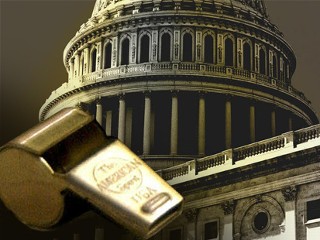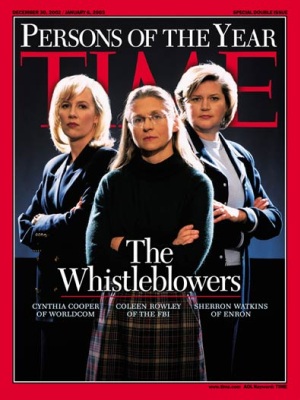Closing Loopholes with New Whistlerblower Protection Legislation and Dispensing the View of Whistleblowers as Mere Disgruntled Employees
Following the havoc of corporate scandals caused by Enron, Worldcom, and Madoff and Stanford’s Ponzi scheme, instances of corporate fraud and whistleblowing is no longer a novel subject matter today. Accordingly, questions surrounding the extent of ethical responsibility of those employees ancillary to the fraud emerged but with no clear answer. Blowing the whistle on one’s own employer certainly appears to be a violation of loyalty and other fiduciary obligations, while on the other hand, whistleblowers serve an important function in enforcing corporate compliance. Retaliation often follows and whistleblowers are inevitably in need of legal protection. These two interests collide head on, leaving open a number of questions as to the nature of an employee’s fiduciary duty, the policy rationales for protecting whistleblowers and the approach that the law must take. In the meantime, with the rise of litigation involving whistleblowers in recent years, there has been movement in Congress to enact a new statute that will further expand whistleblower protection and close loopholes in current legislation, particularly in the financial and banking industry.
Background of Whistleblower Legislation
Among others, Congress enacted three notable statutes to protect whistleblowers from retaliation: the Whistleblower Protection Act of 1989, the Sarbanes-Oxley Act, and the Securities and Exchange Commission’s Dodd-Frank Wall Street Reform and Consumer Protection Act.
The Whistleblower Protection Act (“WPA”) was enacted in 1989 by the 101st Congress which took the foundation laid by the Civil Service Reform Act of 1978 and expanded the provisions to increase protection for whistleblowers. The WPA forbids the federal government from reprisal against federal government employees for blowing the whistle and encourages employees to report wrongful conduct of federal government employers by means of monetary awards. The WPA remains the primary federal statute that guarantees federal employees whistleblower protection, although, under this statute private sector employees do not have standing for a cause of action.
The Sarbanes-Oxley Act (“SOX Act” or “the Act”), promulgated in 2002 in response to the Enron and WorldCom debacle, significantly expanded the scope of whistleblower protection and increased regulation of businesses in order to deter and detect fraud, particularly corporate and securities fraud. The statute reaches employees in the private sector, particularly those employed by publicly held companies. It was one of the “first set of comprehensive federal whistleblower provisions protecting employees who raise concerns about a violation of any federal criminal statute.”
In spite of the enactment of the SOX Act, which was hailed at the time as one of the most comprehensive bodies of law enacted to deter and prevent corporate malfeasance, another series of corporate fraud mayhem, most notably the fifty billion dollar Ponzi scheme perpetrated by Madoff and Stanford, in addition to the 2008 financial crisis, caused Congress to pass the Dodd-Frank Wall Street Reform and Consumer Protection Act in 2010 (“Dodd-Frank Act” or the Act”). The purpose of the statute was clearly to deter corporate malfeasance as well as other illegal business practices. In the process, the Dodd-Frank Act broadened whistleblower protection even further beyond the bounds of the SOX Act by expanding whistleblower protection to beyond public companies and by increasing monetary incentives to report perpetration of fraud to government agencies.
Nonetheless, the Dodd-Frank Act is not without loopholes. Among others, the statute does not expressly provide for individual liability nor defines the term “employer.” This leaves open an interpretation strongly suggesting inapplicability of the anti-retaliation provisions to individuals. It also leaves open the definition of “covered employee” who may be entitled to whistleblower protection, which makes room for arguments for varying interpretations and perhaps more litigation. Furthermore, the statute is silent regarding the enforceability of non-disclosure agreements that restrict the employees from disclosing confidential information or present employees with a waiver of their protected rights under whistleblower legislation. In practice, some companies have internally disciplined whistleblowers for communications with the government.
Latest Statistics
In practice, during the last decade, whistleblowing cases received have increased in significant numbers. In 2005, cases filed by complainants under various agencies and statutes including the Occupational Safety and Health Administration (“OSHA”), Sarbanes Oxley Act (“SOX”), and the Surface Transportation Assistance Act (“STAA”) totaled 1934; by 2015, this number climbed to 3288. What is notable is that amongst the dramatic increase of complaints, the rates of positive outcomes have stayed relatively steady. Out of the total number of cases received in 2005, 20 percent counted for positive outcomes for complainants while 66 percent of cases were dismissed. In 2015, the positive outcome for complainants amounted 25 percent of all cases and 50 percent of total cases received were dismissed. It is also notable that despite a significant increase in the total number of cases received, the number of cases given merit have stayed roughly the same. Out of 1902 cases in 2005, 41 cases were given merit. However, in 2015, out of 3337 cases, only 45 cases were given merit. Most of the positively regarded outcomes were settled. Thus, generally, in enforcing the 22 whistleblower statutes, OSHA dismissed a fair number of cases received and a very small percentage of the claims have been given merit. It is apparent that in spite of the increased frequency of whistleblowing, complainants are still predominantly viewed as mere disgruntled employees that dispose their loyalty rather than those internally convicted to adhere to their personal ethical standards.
New Legislation
On February 25, 2016 Representative Cummings and Senator Baldwin submitted H.R. 4619 and S.2591 also known as Whistleblower Augmented Reward and Non-Retaliation (WARN) Act in order to “to provide heightened protections for those who blow the whistle on suspected financial misconduct.” The sponsors of the bill said in a press release that the legislation is “to combat retaliation against whistleblowers and to close loopholes in the DoddFrank Act relied upon by Wall Street giants.” The new statute will increase whistleblower protection by expanding whistleblower protections and providing additional legal procedures for such protections. The bill attempts to do this by prohibiting employers from “forcing whistleblowers to waive their rights or disclose their communications with the government; safeguard whistleblowers from retaliation if they refuse to participate in activities they believe to be in violation of the law”; harmonize whistleblower awards under the Dodd-Frank Act with other relevant statutes so that whistleblowers are “eligible to receive between 10 percent and 30 percent of penalties and recoveries”; apply additional “procedures, evidentiary standards, and burdens of proof” allowing whistleblower to show that their actions led to unfavorable personnel actions.
The WARN Act is endorsed by Americans for Financial Reform, the AFL-CIO and the Communication Workers of America, and other organizations. So far, there has been no notably strong opposition to the bill since it has been referred to the Subcommittee on Commodity Exchanges, Energy, and Credit. Although the bill proposes some changes that are rather drastic and thus proponents of the bill expect some opposition that may find the bill extremely employee-friendly, they believe this to be “good legislation” that will improve whistleblower protection.
Planes, Change, and International Deals: A Global Measure to Curb Aviation Emissions
In October 2016, the United Nations’s agency for aviation policy, the International Civil Aviation Organization (ICAO), announced an international agreement to control carbon emissions on international flights. Considering that commercial aviation accounts for over 2% of global carbon emissions—and is growing rapidly every day—this is an issue at the forefront of the climate change debate.
Regulating carbon emissions from commercial airlines has proven challenging over the years. While many industries have been pressured to closely control or even shrink their carbon footprint, between 1990 and 2014, aviation emissions grew by an estimated 80 percent. The Kyoto Protocol delegated airline regulation to the ICAO, which can be viewed as an international version of the U.S. Federal Aviation Administration (FAA). The ICAO provides standardization for international flights, ensuring pilots know where to go, who to talk to along the way, and what to do once they get to their destination. Part of this work is done through Standards and Recommended Practices (SARPs), which include maps and navigational approach plates. The ICAO also includes a Committee on Aviation Environmental Protection, but its SARPs are simply recommendations and the airline industry plays a large role in its decision making process.
 In 2005, the European Union (EU) addressed aviation carbon emissions after finding the ICAO’s proposed emissions trading system “unattractive”. In 2008, the European Council promulgated EU Directive 2008/101/EC, which expanded the EU’s Emissions Trading Scheme (ETS), a “cap and trade” program, to include aviation carbon output by 2012. What seemed like a relatively simple expansion of an effective environmental program sparked vigorous debate and nearly set off an international trade war. Because emissions were calculated for the entirety of a flight route, countries outside of the EU claimed both a violation of state sovereignty and an unfair advantage for European carriers. In 2009, American, United, and Continental Airlines banded together with the trade group Air Transport Association of America (ATAA) to bring an action claiming the EU regulations were incompatible with international law. In December 2011, the European Court of Justice (ECJ) found the directive complied with international customary law and did not violate previous US-EU agreements for flights arriving or departing from European airports.
In 2005, the European Union (EU) addressed aviation carbon emissions after finding the ICAO’s proposed emissions trading system “unattractive”. In 2008, the European Council promulgated EU Directive 2008/101/EC, which expanded the EU’s Emissions Trading Scheme (ETS), a “cap and trade” program, to include aviation carbon output by 2012. What seemed like a relatively simple expansion of an effective environmental program sparked vigorous debate and nearly set off an international trade war. Because emissions were calculated for the entirety of a flight route, countries outside of the EU claimed both a violation of state sovereignty and an unfair advantage for European carriers. In 2009, American, United, and Continental Airlines banded together with the trade group Air Transport Association of America (ATAA) to bring an action claiming the EU regulations were incompatible with international law. In December 2011, the European Court of Justice (ECJ) found the directive complied with international customary law and did not violate previous US-EU agreements for flights arriving or departing from European airports.
International reaction to the ruling was swift and overwhelmingly negative as the EU ETS expansion went forward. China prohibited its national airlines from paying the European carbon emission charges, and it suspended $14 billion in orders from European aircraft manufacturers. In 2012, President Obama signed the “European Union Emissions Trading Scheme Prohibition Act,” which barred American carriers from paying the EU ETS as well. Even the ICAO called for the European Union to exempt non-European airlines from the EU ETS. Under heavy international pressure, the European Union paused enforcement of the Aviation Directive in November 2012 to give the ICAO another chance to regulate aviation carbon emissions. Subsequent ICAO inaction created unease in the international community, with many frustrated by the lack of progress in aviation greenhouse gas regulation since the Kyoto Protocol. However, continued international resistance to the EU ETS led to a compromise giving the ICAO until the end of 2016 to meet its goals.
On October 7, 2016 the ICAO General Assembly resolved to implement a Global Market-Based Measure (GMBM) regulating aircraft emissions. While the plan will not take effect for another five years and not see full implementation for another twenty, the agreement is still being hailed as an “historic” achievement by creating the first carbon market in any industry sector.
Different from the EU ETS “cap and trade”, this plan proposes the Carbon Offsetting and Reduction Scheme for International Aviation (CORSIA) to complement emissions mitigation factors already put in place by governments and the aviation industry. According to the ICAO,
The CORSIA calls for international aviation to address and offset its emissions through the reduction of emissions elsewhere (outside of the international aviation sector), involving the concept of ‘emissions units’...
Offsetting could be through the acquisition and redemption of emissions units, arising from different sources of emissions reductions achieved through mechanisms… programmes… or projects…. The buying and selling of eligible emissions units happens through a carbon market. The carbon market is a commodity market with the underlying commodity being emissions units.
Offsetting allows airlines to buy credits for those emissions they cannot reduce, putting money into renewable energy projects or companies actively reducing carbon output and allowing a growing airline industry to remain carbon-neutral.
CORSIA will be implemented in several phases, starting in 2021. Initially the program will be voluntary, but by 2027 it will mandatory for most countries. Fortunately, as of October 2016, sixty-six countries accounting for 86.5% of the world’s aviation activity (including the US and China) have declared their intent to participate voluntarily from the initial phases of the program in 2021.
The long and windy road to the ICAO’s development of a truly global market-based measure to regulate carbon emissions is a fascinating case study of the complex nature of international law. The inaction of the UN’s ICAO led to action by another international organization, the European Union. The EU’s action was met with resistance from multi-national corporations and state governments, forcing action by the ICAO. Despite all of the competing interests, a common goal will finally be realized as countries participate in CORSIA. It remains to be seen how effective CORSIA will be combatting climate change, but it seems like a promising step in the right direction: international compromise leading to a victory for the environment.




